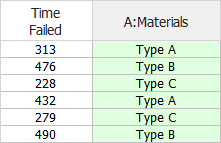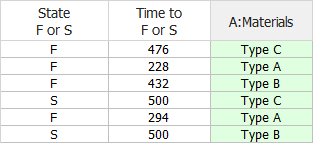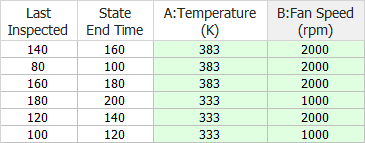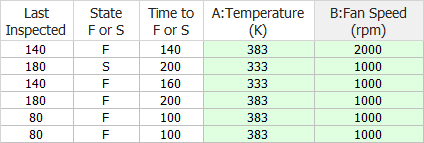Reliability Design Data Types
Reliability designs allow you to enter life data (i.e., times-to-failure data) as the response. Depending on the censoring type you select, other information may also be included. When you are selecting the design settings in a design folio, you can select Life Data as the response type and then choose an option from the Censoring drop-down list on the Design tab. (See Adding, Removing and Editing Responses.)

The censoring option you choose will determine which of the following data types is used in the design:
- Life Data with No Censoring (Complete Data): Complete data are obtained by recording the exact times when the units failed. For example, if we tested five units and they all failed, and we recorded the time when each failure occurred, we would then have complete information as to the time of each failure in the sample. Complete data are shown next in the context of a one factor reliability design.

- Life Data with Suspensions (Right Censored Data): The data points for units that did not fail during the observation period are known as suspensions or right censored data, which means that the event of interest (i.e., the failure time) is to the right of our data point on the time scale. For example, if we tested six units and only four had failed by the end of the test, the observed operating time of the two units that did not fail would be referred to as right censored data. Failure times with right censored data are shown next in the context of a one factor reliability design (e.g., the last data point is a suspension at time = 500).

- Life Data with Intervals: Interval censored data sets contain uncertainty as to when the units actually failed. For example, if five units under test are inspected every 100 hours, then the status of each unit (failed or still running) is known only at the time of each inspection. If a unit fails, it is known only that it failed between inspections and the exact time of failure is not known. Instead of an exact failure time, an interval of time (e.g., between 0 and 100 hours, or 100 and 200 hours) would be recorded. Interval data are shown next in the context of a factorial reliability design (e.g., the first data point indicates that a failure occurred at some time between 140 and 160 hours).

- Life Data with Both Suspensions and Intervals: This is the most general data type, as it includes all of the possible censoring types. Failure times with interval and right censored data type are shown next in the context of a factorial reliability design. (Note that the first data point is actually an exact failure time since it has an interval with identical start and end times.)
